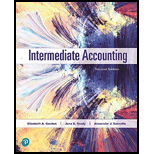
Intermediate Accounting (2nd Edition)
2nd Edition
ISBN: 9780134730370
Author: Elizabeth A. Gordon, Jana S. Raedy, Alexander J. Sannella
Publisher: PEARSON
expand_more
expand_more
format_list_bulleted
Concept explainers
Question
Chapter 21, Problem 21.5E
a.
To determine
The original cost of plant asset.
Given information:
Net book value of asset after 10 years is $2,600,000 on Jan 1 of current year.
Expected residual value is $500,000.
Estimated useful life is 25 years.
b.
To determine
The annual depreciation for first 10 years.
Given information:
Net book value of asset after 10 years is $2,600,000 on Jan 1 of current year.
Expected residual value is $500,000.
Estimated useful life is 25 years.
c.
To determine
To prepare: The
Given information:
Net book value of asset after 10 years is $2,600,000 on Jan 1 of current year.
Revised expected residual value is $100,000.
Revised estimated useful life is 20 years.
d.
To determine
To prepare: The footnote disclosure for change in accounting estimate.
Expert Solution & Answer
Want to see the full answer?
Check out a sample textbook solution
Students have asked these similar questions
Neptune Electronics had sales of $520,000 and a cost of goods sold (COGS) of $310,000. Calculate its gross profit.i want answer
Neptune Electronics had sales of $520,000 and a cost of goods sold (COGS) of $310,000. Calculate its gross profit.solve this?
Please help me with this question general Accounting
Chapter 21 Solutions
Intermediate Accounting (2nd Edition)
Ch. 21 - Are accounting changes permitted in financial...Ch. 21 - How do firms report accounting changes under the...Ch. 21 - Prob. 21.3QCh. 21 - How do firms account for changes in accounting...Ch. 21 - Prob. 21.5QCh. 21 - Prob. 21.6QCh. 21 - Prob. 21.7QCh. 21 - Prob. 21.8QCh. 21 - Do accounting errors that self-correct within two...Ch. 21 - Does a firm need to correct an error that...
Ch. 21 - Prob. 21.1MCCh. 21 - Prob. 21.2MCCh. 21 - Prob. 21.3MCCh. 21 - Prob. 21.4MCCh. 21 - Prob. 21.5MCCh. 21 - Prob. 21.1BECh. 21 - Prob. 21.2BECh. 21 - Prob. 21.3BECh. 21 - Prob. 21.4BECh. 21 - Change in Accounting Principle, Long-Term...Ch. 21 - Prob. 21.6BECh. 21 - Prob. 21.7BECh. 21 - Prob. 21.8BECh. 21 - Prob. 21.9BECh. 21 - Prob. 21.10BECh. 21 - Prob. 21.11BECh. 21 - Prob. 21.12BECh. 21 - Prob. 21.13BECh. 21 - Prob. 21.14BECh. 21 - Change in Accounting Principle, Inventory. Massi...Ch. 21 - Change in Accounting Principle, Long-Term...Ch. 21 - Prob. 21.3ECh. 21 - Change in Accounting Principle, Inventory. Winthur...Ch. 21 - Prob. 21.5ECh. 21 - Prob. 21.6ECh. 21 - Error Analysis and Correction. Feinstein and...Ch. 21 - Prob. 21.8ECh. 21 - Prob. 21.9ECh. 21 - Prob. 21.10ECh. 21 - Change in Accounting Principle, Inventory. Second...Ch. 21 - Prob. 21.2PCh. 21 - Prob. 21.3PCh. 21 - Prob. 21.4PCh. 21 - Prob. 21.5PCh. 21 - Change in Estimate, Inventory, Bad Debt Expense....Ch. 21 - Prob. 21.7PCh. 21 - Cases Judgment Case Judgment Case: Materiality and...Ch. 21 - Prob. 1FSCCh. 21 - Surfing the Standards: Change in Accounting...Ch. 21 - Prob. 1BCC
Knowledge Booster
Learn more about
Need a deep-dive on the concept behind this application? Look no further. Learn more about this topic, accounting and related others by exploring similar questions and additional content below.Similar questions
- Estimate cost of goods sold in dollars would bearrow_forwardPlease provide answerarrow_forwardRadium Tech Inc. has net sales of $320,000, cost of goods sold of $210,000, selling expenses of $15,000, and non-operating expenses of $6,000. What is the company's gross profit? correct answerarrow_forward
arrow_back_ios
SEE MORE QUESTIONS
arrow_forward_ios
Recommended textbooks for you
 Intermediate Accounting: Reporting And AnalysisAccountingISBN:9781337788281Author:James M. Wahlen, Jefferson P. Jones, Donald PagachPublisher:Cengage Learning
Intermediate Accounting: Reporting And AnalysisAccountingISBN:9781337788281Author:James M. Wahlen, Jefferson P. Jones, Donald PagachPublisher:Cengage Learning College Accounting, Chapters 1-27AccountingISBN:9781337794756Author:HEINTZ, James A.Publisher:Cengage Learning,
College Accounting, Chapters 1-27AccountingISBN:9781337794756Author:HEINTZ, James A.Publisher:Cengage Learning,

Intermediate Accounting: Reporting And Analysis
Accounting
ISBN:9781337788281
Author:James M. Wahlen, Jefferson P. Jones, Donald Pagach
Publisher:Cengage Learning

College Accounting, Chapters 1-27
Accounting
ISBN:9781337794756
Author:HEINTZ, James A.
Publisher:Cengage Learning,
Accounting for Derivatives_1.mp4; Author: DVRamanaXIMB;https://www.youtube.com/watch?v=kZky1jIiCN0;License: Standard Youtube License
Depreciation|(Concept and Methods); Author: easyCBSE commerce lectures;https://www.youtube.com/watch?v=w4lScJke6CA;License: Standard YouTube License, CC-BY